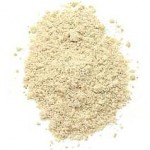 One of the things I want to address before continuing with specific breads is flour: What kind of flour are you using? Because there is a big difference between baking with whole wheat flour and white flour.
One of the things I want to address before continuing with specific breads is flour: What kind of flour are you using? Because there is a big difference between baking with whole wheat flour and white flour.
One major difference is nutrition. Whole wheat flours have more fiber and more nutrients. Using whole wheat flours is healthy, and it will give you a different bread than using white flour. Whole wheat breads are denser and heartier. They taste great, but baking with them is a little trickier than with white doughs, and this can lead to baker frustration.
White flours have been stripped of some of their essential fibers and nutrients, but they will give you a light, delicious bread. I used whole grain flours (or a mixture of them and white) for several years. I prefer to work with white flour now. However, you never forget how to bake with whole grains once you’ve learned.
Possibly the best resource available for information about baking with whole grains is the Laurel’s Kitchen Bread Book. It contains some fabulous recipes too. But here are 7 good rules of thumb:
1) Whole wheat doughs rise much more slowly than white flours. Last week, my friend Talia asked me to come over and make bread with her. We decided to make challah. I found out at the very last minute that all she had on hand was whole wheat flour. No big deal; but we did have to make some adjustments.
2) Whole wheat doughs require a larger liquid to flour ratio. Our recipe called for 1 1/2 cups of liquid; it also called for 7-8 cups of flour. We used only 6 cups of flour, but ended up using a few more tablespoons of water than the recipe originally called for.
3) When you are kneading a white-flour dough, if the dough is sticky, you will want to add more flour, a tablespoon at a time, until the dough is no longer sticky.
4) When you are kneading whole wheat dough, if the dough is sticky, you will want to add more water to your hands and knead it in to the dough until it is no longer sticky.
5) Whole wheat doughs are a lot more stiff than white flour doughs, so they need to be kneaded longer. Where you can knead a white flour dough in 5-to-10 minutes, you will have to knead a whole wheat dough for 15-to-20 minutes. This is also crucial to developing the gluten, which will help transform flour and water into bread.
6) Back to number 1: whole wheat doughs may not appear to rise at all after an hour or more. Go ahead and punch them down anyway. You may want to consider doubling your yeast amount when baking with whole grains; otherwise, you are going to want the luxury of time. I might start a dinner loaf of white flour bread at 3p.m. However, if I am baking with whole grains, I usually start in the morning.
7) You will want to allow your whole wheat dough to rise at least twice; you can sometimes get away with one rise for a white flour dough.
If you keep all of these fun facts in mind when baking with whole grains, you will have more enjoyment and baking success.
You know what? I’ve been making homemade breads for a little while now, and I like to use whole wheat flour when I can. Out of everything I’ve read in books and on the web, I’ve NEVER come across any of that info, except for the part about needing to use more water. So, thank you! That takes a lot of the confusion out of the process, lol.
Thanks, Cate!
Thanks so much for this information. I have been baking my own bread for about a year now; trying to economize when good bread is four dollars a loaf. My white bread has gotten pretty good but whenever I tried substituting 1/3 wheat flour for the white I never got the right texture. This is very helpful!